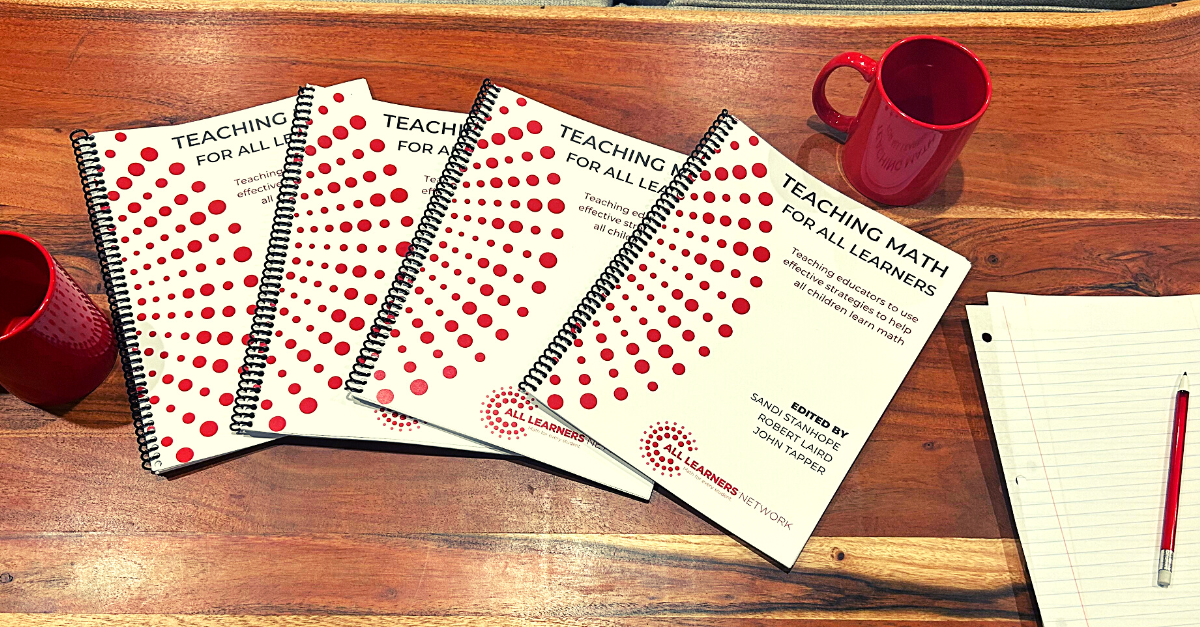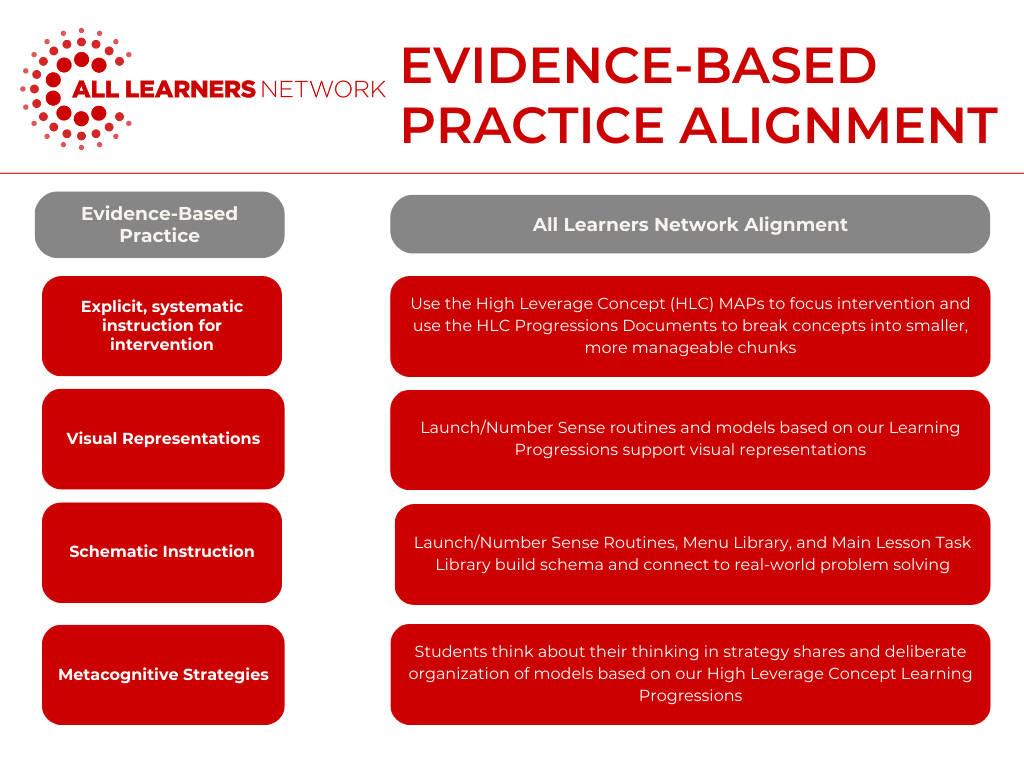
All Learners Network's Evidence-Based Practices Alignment
Evidence-based practices (EBPs) are specific strategies, activities, or programs that have been found to be effective for improving student outcomes and backed by rigorous, high-standard research, replicated with positive outcomes (What Works Clearinghouse, 2020).
The All Learners Network (ALN) professional development, resources, and models are highly aligned with evidence-based practices in mathematics. This document provides an overview of the research and the ALN professional development and resources that demonstrates this alignment, outlined in the below table and discussed in the subsequent sections of this resource.

Explicit, Systematic Instruction
Explicit, systematic instruction involves teaching a specific concept or procedure in a highly structured and carefully sequenced manner. The key components of explicit, systematic instruction include clearly identifying the skills or concepts to be learned, connecting the new content to previous learning, providing opportunities for practice and planning instruction so that concepts build on one another. Explicit instruction emphasizes the use of scaffolding using models to deepen students' understanding of a mathematical concept by building connections between concrete, representational, and abstract models. A student with access to explicit systematic instruction has the opportunity to build robust connections between concrete, representational, abstract models within a concept while building conceptual understanding at all grade levels.
Through this learning process, students first use models to make sense of problem solving. Whether through the physical manipulation of concrete objects or through pictorial representations or through numbers and equations, students make sense of important math concepts with strategies and models that help them understand the problem. Educators who support explicit, systematic instruction of the high leverage concepts at every level spend time facilitating with students connections between the diverse approaches including different models and ways of thinking.
All Learners Network uses the High Leverage Concepts (HLCs) as our focused concept for intervention and remediation. The ALN Lesson Structure promotes using systematic instruction during Main Lesson and teacher time during Math Menu to build on previous understanding and provide additional scaffolding related to the HLCs to engage in an inquiry-based learning opportunity on grade-level content. When planning math instruction, teachers should consider the priority concepts from previous grade levels that support their current learning objectives and consider scaffolds that students may need in order to participate in grade-level learning. Using the ALN Approach, educators learn to clearly identify the learning goal and communicate it to students and use models and quality math tasks to support students in developing their understanding of priority math concepts.
Visual Representations
A visual representation is an accurate depiction of a given problem’s mathematical quantities and relationships. The purpose of this visual is to reflect a student’s understanding of the problem and to help them correctly solve it. The use of visual models also makes student thinking visible to others. Some visual representations or models that support students’ mathematical understanding include:
- Number lines
- Tape diagrams
- Pictures
- Graphs/charts
- Manipulatives
- Ten frames
- Base Ten Blocks
All Learners Network has identified the key models for intervention in our High Leverage Concept maps. We have found that certain models have a longer “shelf life” and can be used to extend a students’ understanding over multiple grades. For example a number line is a visual representation that can be used in second grade to model adding and subtracting whole numbers within 100 and can then be used throughout 3rd and 4th grade to model adding and subtracting larger numbers. In fifth grade, students could continue to use this model to represent comparing and ordering fractions, as well as adding and subtracting fractions. Our HLC Learning Progressions identify these key models and support teachers, special educators and interventionists in identifying which models to prioritize for student use, especially during intervention.
Schematic Instruction
Schematic instruction involves supporting students in learning how to identify word problem types based on a given problem’s underlying structure, or schema. Some students experience difficulty interacting with word problems based on readability, mathematics vocabulary, understanding and experience with the context and identifying relevant versus irrelevant information.
All Learners Network promotes using a Problem Introduction Protocol to increase access to complex word problems. This is especially important when seeking to remove barriers to grade level mathematics for ALL learners. Here is a link to a blog post explaining the benefit and routine related to the Problem Introduction Protocol and a downloadable PDF of this routine.
Metacognitive Strategies
Metacognitive strategies enable students to become aware of how they think when solving mathematics problems. Teaching students to be aware of HOW they think promotes students in practicing the CCSSM: Standards of Mathematical Practice, including making sense of problems and persevering to solve them. Students need to consider how they will approach a mathematical problem, check to see whether their problem-solving approach is working and then confirm if their answer makes sense.
All Learners Network supports students in using metacognitive strategies by using the Problem Introduction Protocol (as mentioned above), as well as by using “low floor, high ceiling tasks” that provide access points for all while leaving the problem open ended enough that students can continue to think more deeply about the math concept. The HLC Progressions documents support educators in identifying a priority concept to focus on.
In our workshops and in district coaching sessions, we support educators in selecting high quality tasks that promote metacognitive thinking. During the Main lesson, the teacher poses an accessible (low floor, high ceiling) task to all students, students collaborate on solving the problem and then strategies are shared in the debrief so students can add on to each other's thinking, revoice other’s thinking and compare and contrast their strategies. This collaborative effort promotes students using metacognitive thinking strategies when solving math problems.
Resources
- https://www.alllearnersnetwork.com/
- https://iris.peabody.vanderbilt.edu/module/math/cresource/q1/p03/
- https://ies.ed.gov/ncee/wwc/Math/
- https://ttac.odu.edu/curriculum-and-instruction/using-evidence-based-math-strategies-to-specially-design-instruction/
- https://portal.ct.gov/-/media/SDE/ESSA-Evidence-Guides/ESSA_EvidenceBasedGuide_Mathematics.pdf




